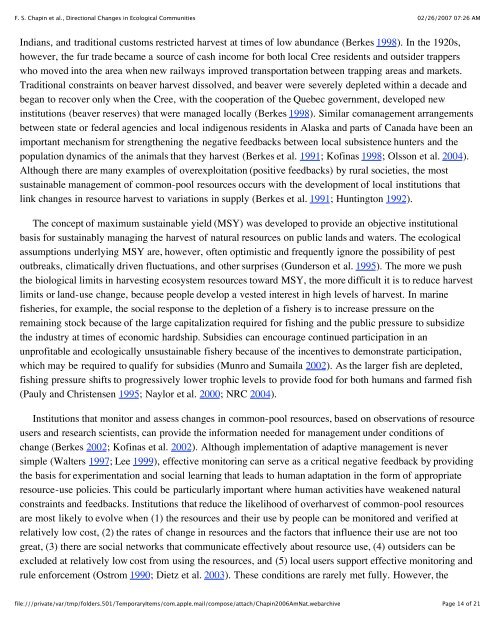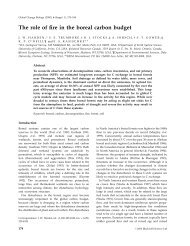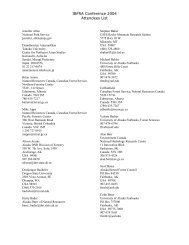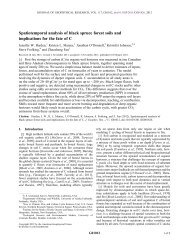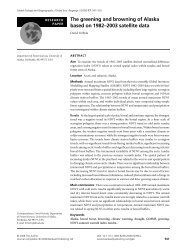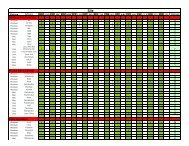Chapin, F.S., III, M.D. Robards, H.P. Huntington, J.F. Johnstone, S.F. ...
Chapin, F.S., III, M.D. Robards, H.P. Huntington, J.F. Johnstone, S.F. ...
Chapin, F.S., III, M.D. Robards, H.P. Huntington, J.F. Johnstone, S.F. ...
You also want an ePaper? Increase the reach of your titles
YUMPU automatically turns print PDFs into web optimized ePapers that Google loves.
F. S. <strong>Chapin</strong> et al., Directional Changes in Ecological Communities<br />
02/26/2007 07:26 AM<br />
Indians, and traditional customs restricted harvest at times of low abundance (Berkes 1998). In the 1920s,<br />
however, the fur trade became a source of cash income for both local Cree residents and outsider trappers<br />
who moved into the area when new railways improved transportation between trapping areas and markets.<br />
Traditional constraints on beaver harvest dissolved, and beaver were severely depleted within a decade and<br />
began to recover only when the Cree, with the cooperation of the Quebec government, developed new<br />
institutions (beaver reserves) that were managed locally (Berkes 1998). Similar comanagement arrangements<br />
between state or federal agencies and local indigenous residents in Alaska and parts of Canada have been an<br />
important mechanism for strengthening the negative feedbacks between local subsistence hunters and the<br />
population dynamics of the animals that they harvest (Berkes et al. 1991; Kofinas 1998; Olsson et al. 2004).<br />
Although there are many examples of overexploitation (positive feedbacks) by rural societies, the most<br />
sustainable management of common-pool resources occurs with the development of local institutions that<br />
link changes in resource harvest to variations in supply (Berkes et al. 1991; <strong>Huntington</strong> 1992).<br />
The concept of maximum sustainable yield (MSY) was developed to provide an objective institutional<br />
basis for sustainably managing the harvest of natural resources on public lands and waters. The ecological<br />
assumptions underlying MSY are, however, often optimistic and frequently ignore the possibility of pest<br />
outbreaks, climatically driven fluctuations, and other surprises (Gunderson et al. 1995). The more we push<br />
the biological limits in harvesting ecosystem resources toward MSY, the more difficult it is to reduce harvest<br />
limits or land-use change, because people develop a vested interest in high levels of harvest. In marine<br />
fisheries, for example, the social response to the depletion of a fishery is to increase pressure on the<br />
remaining stock because of the large capitalization required for fishing and the public pressure to subsidize<br />
the industry at times of economic hardship. Subsidies can encourage continued participation in an<br />
unprofitable and ecologically unsustainable fishery because of the incentives to demonstrate participation,<br />
which may be required to qualify for subsidies (Munro and Sumaila 2002). As the larger fish are depleted,<br />
fishing pressure shifts to progressively lower trophic levels to provide food for both humans and farmed fish<br />
(Pauly and Christensen 1995; Naylor et al. 2000; NRC 2004).<br />
Institutions that monitor and assess changes in common-pool resources, based on observations of resource<br />
users and research scientists, can provide the information needed for management under conditions of<br />
change (Berkes 2002; Kofinas et al. 2002). Although implementation of adaptive management is never<br />
simple (Walters 1997; Lee 1999), effective monitoring can serve as a critical negative feedback by providing<br />
the basis for experimentation and social learning that leads to human adaptation in the form of appropriate<br />
resource-use policies. This could be particularly important where human activities have weakened natural<br />
constraints and feedbacks. Institutions that reduce the likelihood of overharvest of common-pool resources<br />
are most likely to evolve when (1) the resources and their use by people can be monitored and verified at<br />
relatively low cost, (2) the rates of change in resources and the factors that influence their use are not too<br />
great, (3) there are social networks that communicate effectively about resource use, (4) outsiders can be<br />
excluded at relatively low cost from using the resources, and (5) local users support effective monitoring and<br />
rule enforcement (Ostrom 1990; Dietz et al. 2003). These conditions are rarely met fully. However, the<br />
file:///private/var/tmp/folders.501/TemporaryItems/com.apple.mail/compose/attach/<strong>Chapin</strong>2006AmNat.webarchive<br />
Page 14 of 21


